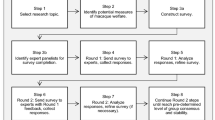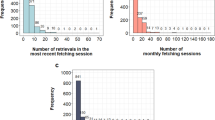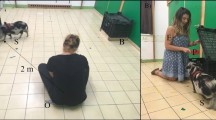Abstract
Conventional methods of capturing marmosets and other small nonhuman primates (NHPs) require prolonged physical contact between animals and their handlers. This causes NHPs to become stressed and exhausted and can put both animals and handlers at risk of injury or exposure to infectious diseases. The authors designed a self-contained device for the capture and transport of small NHPs. Food rewards encourage primates to enter the device independently, and handlers can then easily access the animals for routine veterinary or experimental procedures. Preliminary observations suggest that marmosets quickly become accustomed to the device and that the device causes less stress than capture by hand or by net.
This is a preview of subscription content, access via your institution
Access options
Subscribe to this journal
We are sorry, but there is no personal subscription option available for your country.
Buy this article
- Purchase on Springer Link
- Instant access to full article PDF
Prices may be subject to local taxes which are calculated during checkout




Similar content being viewed by others
References
Rennie, A.E. & Buchanan-Smith, H.M. Refinement of the use of non-human primates in scientific research. Part III: refinement of procedures. Anim. Welfare 15, 239–261 (2006).
Sainsbury A.W., Eaton, B.D. & Cooper, J.E. Restraint and anaesthesia of primates. Vet. Rec. 125, 640–643 (1989).
Luttrell L., Acker, L., Urben, M. & Reinhardt, V. Training a large troop of rhesus macaques to cooperate during catching: analysis of the time investment. Anim. Welfare 3, 135–140 (1994).
Klein, H.J. & Murray, K.A. in Nonhuman Primates in Biomedical Research: Biology and Management (eds. Bennett, B.T., Abee, C.R. & Henrickson, R.) 286–297 (Academic, San Diego, 1995).
Fortman J.D., Hewett, T.A. & Bennett, B.T. The Laboratory Non-human Primate (CRC Press, Ltd., Boca Raton, Florida, 2002).
Fowler, M.E. in Zoo and Wild Animal Medicine 2nd edn. (ed. Fowler, M.E.) 38 (W.B. Saunders, Philadelphia, 1986).
Canadian Council on Animal Care. Guide to the Care and Use of Experimental Animals Vol. 2 (Canadian Council on Animal Care, Ottawa, ON, Canada, 1984; adopted May 1999).
Sauceda, R. & Schmidt, M.G. Refining macaque handling and restraint techniques. Lab Anim. (NY) 29, 47–49 (2000).
Reinhardt, V., Liss, C. & Stevens, C. Restraint methods of laboratory non-human primates: a critical review. Anim. Welfare 4, 221–238 (1995).
Blank, M.S., Gordon, T.P. & Wilson, M.E. Effects of capture and venipuncture on serum levels of prolactin, growth-hormone and cortisol in outdoor compound-housed female rhesus-monkeys (Macaca mulatta). Acta Endocrinol. (Copenh.) 102, 190–195 (1983).
Grant, J.L. & Doudet, D.J. Obtaining blood samples from awake rhesus monkeys (Macaca mulatta). Laboratory Primate Newsletter 42, 1–3 (2003).
Institute of Laboratory Animal Resources, National Research Council. Guide for the Care and Use of Laboratory Animals (National Academy Press, Washington, DC, 1996).
Acknowledgements
Opinions, interpretations, conclusions and recommendations are those of the authors and are not necessarily endorsed by the US Army.
Author information
Authors and Affiliations
Corresponding author
Ethics declarations
Competing interests
The authors declare no competing financial interests.
Rights and permissions
About this article
Cite this article
Williams, P., Poole, M., Katos, A. et al. A new device for the capture and transport of small nonhuman primates in scientific research. Lab Anim 37, 116–119 (2008). https://doi.org/10.1038/laban0308-116
Received:
Accepted:
Issue Date:
DOI: https://doi.org/10.1038/laban0308-116



